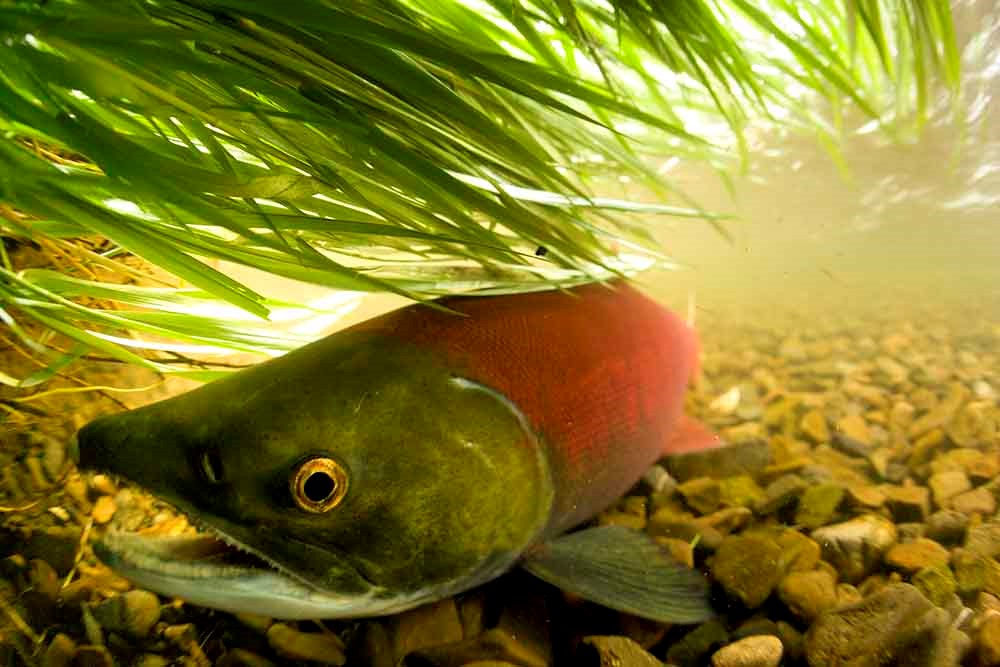Part of a series of articles titled Alaska Park Science - Volume 19, Issue 1 - Below the Surface: Fish and Our Changing Underwater World.
Article
Below the Surface: Fish and Our Changing Underwater World

PHOTO COURTESY OF MICHAEL MELFORD
Alaska encompasses over three million lakes, 12,000 rivers, and an estimated 6,640 miles (10,686 km) of ocean coastline. Below the mirrored surface swim some of the world’s most abundant, healthy, all-wild fish, including iconic salmon, massive halibut, and oil-rich eulachon. Fish sustained Alaska Natives for millennia and now represent food and economic security for many more people.
Alaska’s fish harvest is divided among diverse user groups. Commercial fisheries dominate, com-prising about 98.6% of total harvest; in 2016, the 5.6-billion-pound seafood harvest created 99,000 full time jobs and $12.8 billion in national economic output (McDowell Group 2017). Alaskans rely on seafood jobs with over 21,200 rural and 56,800 total residents employed during 2015/2016 (McDowell Group 2017). Compared to commercial fisheries, similar data valuing Alaska’s recreational fisheries is surprisingly scarce. Sport fisheries harvest less than 0.5% of Alaska’s annual total (Fall 2017), but this fishery is both popular and valuable. Review of 2018 statistics show about 152,000 Alaskans and 305,000 non-residents bought sport fishing licenses in 2018, netting state coffers over $26 million. But that number doesn’t include trip expenditures or jobs created. Analysis of 2007 data (Lew and Larson 2012) indicates Alaskan resident angler average trip values ranged from $246-$444 while non-resident trip values ranged from $2,007-$2,639. Expanding these numbers using the upper trip value suggests Alaskans may spend up to $68 million and non-residents up to $806 million on recreational fishing annually.
Perhaps most important to rural Alaskans are subsistence fisheries. State and federal laws define subsistence as the “customary and traditional uses” of wild resources for food, clothing, fuel, transportation, construction, art, crafts, sharing, and customary trade. Though comprising less than 0.5% of annual fish and game harvests, subsistence is a major component of rural Alaskan food supplies (Fall 2018). About 34 million pounds (15.4 million kg) of fish and game were harvested by rural residents in 2017, about 276 pounds (125 kg) per person, of which 54% was fish (Fall 2018). These harvests supply about 176% of rural resident protein needs; and this value captures some of the culturally-central resource sharing with non-rural relatives. Replacing these wild foods would be extremely expensive; replacement value for rural communities is estimated at $170-$454 million annually (Fall 2018).
Despite the importance of Alaska’s fisheries, surprisingly few national park studies focus on fish and their primary habitat: water. Here we share a range of park-related research on various population- and species-specific fish topics, such as: how bears led biologists to unknown salmon streams; what salmon surveys revealed along a proposed mining road; that halibut really are home bodies; what sonar showed about coho salmon abundance; how tiny, oil-rich, and still largely mysterious eulachon fueled generations of humans; how a water sample can reveal fish biodiversity; proof that ancient Alaskans fished for deep-water cod, and the historical importance of a Bristol Bay cannery. Those studies are complemented by articles on some current and projected impacts on fish habitats from: the changing climate and implications of melting permafrost; sources of mercury in our fish; mining impacts and restoration; and finally, studies and implications of an invasive aquatic plant.
We hope this edition of Alaska Park Science gives you a deeper understanding of what lies below the surface in Alaskan waters and inspires you to get your feet wet exploring further.
Thank you to all our contributing authors!
References
Fall, J. A. 2018.
Subsistence in Alaska: A year 2017 update. Division of Subsistence, Alaska Department of Fish and Game. Anchorage, AK. Available at: https://www.adfg.alaska.gov/static/home/subsistence/pdfs/subsistence_update_2017.pdf (accessed February 20, 2020)
Lew, D. K. and D. M. Larson. 2012.
Economic values for saltwater sport fishing in Alaska: A stated preference analysis. North American Journal of Fisheries Management 32(4): 745-759.
McDowell Group. 2017.
The economic value of Alaska’s seafood industry. Alaska Seafood Marketing Institute. Available at: https://www.alaskaseafood.org/wp-content/uploads/2015/10/AK-Seadfood-Impacts-Sep2017-Final-Digital-Copy.pdf (accessed February 20, 2020)
Last updated: May 29, 2024
